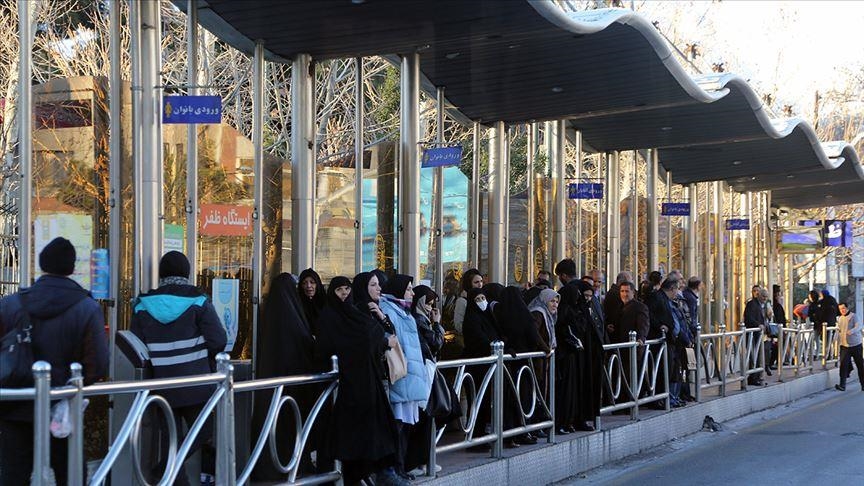Economic crises stare Iran due to aging population, low fertility rates
On World Population Day, social scientists say low population growth rate has potential to lead shortage of workforce and further economic woes

TEHRAN, Iran
Low fertility rates and high life expectancy is leading to an aging population in Iran, which has the potential to grave economic crises, according to experts.
Coinciding the World Population Day, which is being observed on Monday, Tehran-based social scientist Mostafa Shahriari told Anadolu Agency that there is a danger of a shortage of workforce and thus an economic downslide in the country due to low fertility rates and aging population.
While 1.59 million new births were registered in the Iranian calendar year 2015-2016, it plummeted to about one million in the year 2020-2021, pointing to a low population growth rate and aging population, as per data from the Statistical Center of Iran.
Mohammad Eesa, 76, a village elder from the hamlet of Khorramdasht in central Iran’s Qazvin province, said he has never in his lifetime seen such sluggish population growth.
His native province was once known for its burgeoning youth population.
“It is sad and worrying that our beautiful country is aging so fast,” he told Anadolu Agency, attributing it to a myriad of socio-economic factors, including unemployment and delayed marriages.
The septuagenarian had six children from two marriages, but none of his sons or daughters have more than two children, pointing to a trend that is prevalent across the country.
While birth rates and fertility rates have alarmingly dropped around the world in recent decades, from West Asia to North Africa, the case of Iran is very intriguing.
From 6.5 children per woman in the 1980s to 1.6 now, Iran has earned a dubious distinction for having the lowest fertility rate in the entire region, posing fresh challenges for the sanctions-battered country.
Alarming proportion
From 3.9% in 1986, 2.5% in 1991, 1.5% in 1996, 1.6% in 2006, 1.3% in 2011, 1.2% in 2016 to less than 1% in 2021 - the downward trend of the population growth rate in Iran has assumed alarming proportions over the years.
Taking account of decreasing youth population, Iran’s Deputy Health Minister Kamal Heidari last year in December unveiled a plan to arrest the decline in population growth of the country to avoid the collapse of economic and social systems.
"Seven years later, if the trend continues, we will fall into the demographic black hole, and it takes at least 150 years to make up for that," he said.
The national budget for the fiscal year 2021-2022 has earmarked nearly $450 million for implementing childbearing and other support plans.
The concerns about Iran falling into the "demographic black hole", a phenomenon prevalent in countries such as Japan, Italy, and Germany where immigrants are flown to keep the economy running, are shared widely.
Officials and experts have raised alarm bells about the country's population growth rate plummeting to zero in the next decade, which could also spur migration and brain drain.
Shahriari says growing economic problems in recent years in the wake of sanctions have drastically altered social dynamics, with young people delaying their marriages, sticking to family planning, and in some cases applying for migration abroad.
"Issues like stagnant population growth, dropping fertility rates or even demographic changes don't happen in a vacuum," he said, pointing to socio-economic factors such as unemployment, inflation, and change in people's preferences and lifestyles.
Little impact
During the Pahlavi dynasty rule, which ended in 1979, Iran vigorously promoted a West-backed family planning program to control the population growth, but it seemed to have little impact, says Mahdi Mohammadi, a contemporary historian.
"In the years after the 1979 revolution, women in Iran had an average of six children, which was largely due to Ayatollah Khomeini's rejection of Mohammad Reza Pahlavi's population control program, as he thought the program was not compatible with Islam," he said.
But after the first Gulf War in early 1990 was accompanied by severe economic problems two reformist presidents Hashemi Rafsanjani and Mohammad Khatami again promoted the fewer children policy.
In the mid-2000s, when Mahmoud Ahmedinejad rose to power, the family planning program was again shelved. But the number of births per woman continued to fall.
In May 2014, Iran's supreme leader Ayatollah Ali Khamenei outlined a 14-point plan to tackle the problem, which was shared with the parliament, judiciary, and the executive, stressing the "positive role of the population in the progress of the country.”
The plan called for increasing the fertility rate to above replacement levels, eliminating barriers to marriage, reforming the education system, promoting the Islamic lifestyle, and managing immigration, among other points.
In line with the plan, successive governments have taken measures to boost population growth.
"These measures are welcome but it is also essential to address the root cause of the problem, which is the deteriorating economic situation," said Shahriari.
Anadolu Agency website contains only a portion of the news stories offered to subscribers in the AA News Broadcasting System (HAS), and in summarized form. Please contact us for subscription options.


